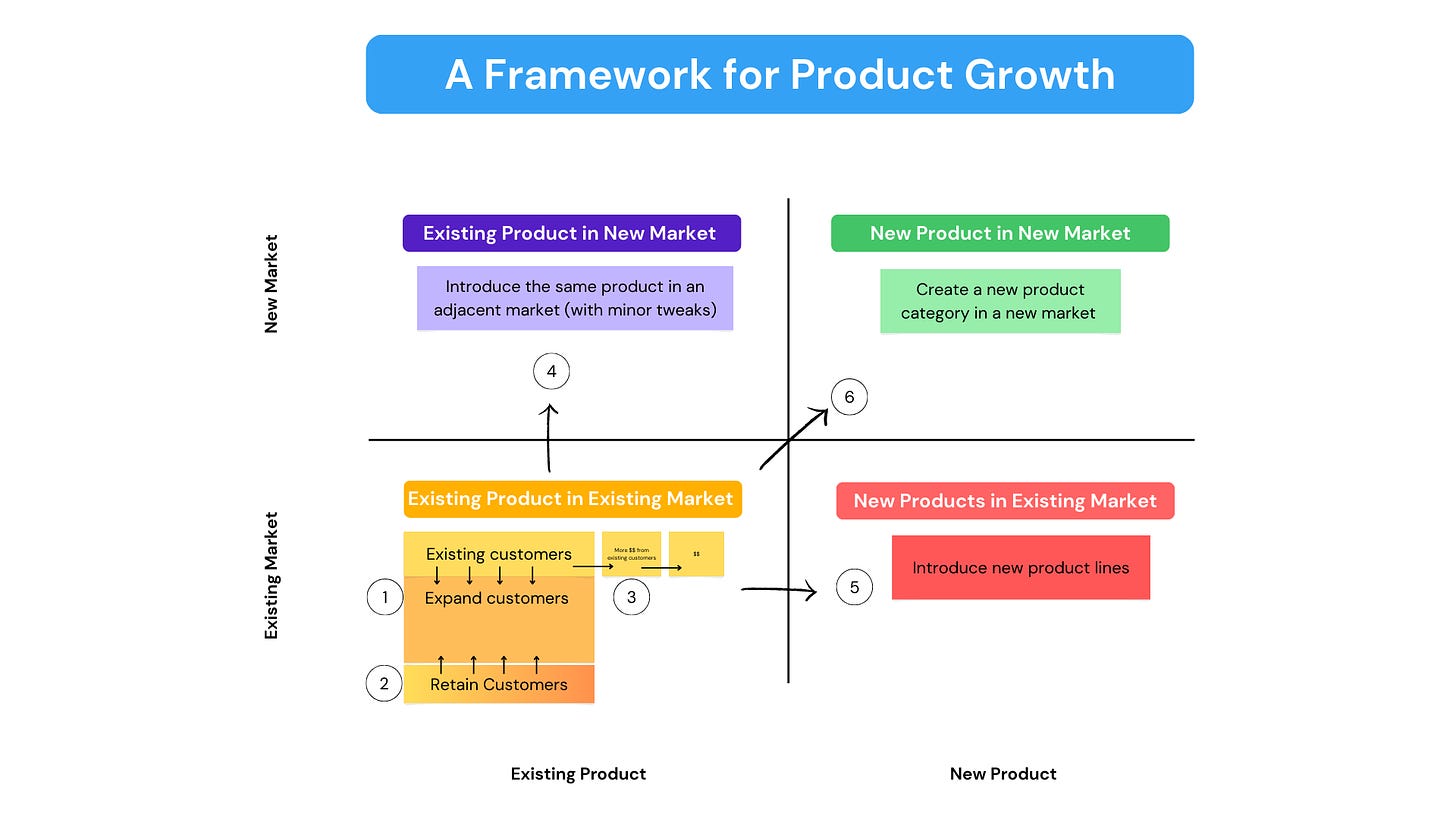Building products in b2b for revenue growth

Product managers primary goal is to grow the business.
It’s not just to gather requirements.
It’s not just to create stories for engineers.
It’s not to just implement a product.
The most critical goal is help grow the revenue for the product you are responsible for.
Now, it does not mean you are doing sales and marketing. No.
There are others in the organization to do that.
But your goal is to figure out what will customers and prospect pay for. Which means you need to understand your market, industry and customers well enough to understand the hidden pain points that your product will solve. And the customer will pay for.
This is a mantra I drill into my students in the PM sessions I teach.
You may argue that you were hired to build a product. Perhaps.
But what capabilities are you building? Who does it benefit the most?
Are you better of building Feature A that will get a certain amount revenue or Feature B that will get less revenue.
It’s also your job to figure out the what and why before you get to how and when.
Don’t get me wrong. You still have to deliver and ensure your product ships. You still need to gather the right requirements and work with engineers. And of course, you still have to deliver value to your users. Value they are willing to pay for.
Let’s deep dive into revenue, in case you are wondering what I am talking about.
In this article, we will talk how you can influence the growth of revenue. We will not not discuss how to calculate revenue or ARR or MRR. I’ll write that separately.
There are 6 main levers at your disposal as a product manager to grow revenue.

-
Expand into ICP
Your product is already used by 100s or 1000s of customers. In order to grow, your sales and marketing team need to find similar customers.
The primary objective as a PM is to keep the product running smoothly, continually improve experience and add incremental features.Keep track of feature requests and prioritize relentlessly. Focus on those enhancements that will help a large segment of existing or new customers. Prioritization is a topic unto itself with 100s of frameworks, so I’ll just keep it at this high level for this article. Prioritize based on the maximum outcome.
As more customers are added, you will realize there are still a few friction points that prevents customers from getting onboarded quickly. Identify them and optimize to streamline the new customer experience. As a PM, you should be able to understand deeply this segment of your customers, the personas, the use cases and the friction points that your product is going to solve. Your job as a PM is to make sure that new customers are getting onboarded and getting to the value point quickly.
When you start expanding your customer base, you will also find a lot of competition. As a PM, you need to ensure your value proposition is better than the competition. It could be a better feature, or better experience. Your goal is to find a way to prevent your competitor to steal your business.
-
Retain Customers
Reducing churn or retaining customers is the life blood for SAAS companies. There is a simple economic argument for reducing churn. It costs more to acquire a new customer than to retain one. As a PM, you should relentlessly research the root causes of churn and aggressively address them. Sometimes the reasons can be as simple as improving the usability. In other cases, there could be complex reasons that require significant investments. Reducing churn is an ongoing effort of experimenting and tweaking and should never stop. For a $ 100M ARR business, a reduction of 1% in churn is $ 1M ARR that is not lost and likely costs less than acquiring the same revenue from new customers.
While this is all sales and finance mumbo jumbo, I advise all PM to learn about retention and track these metrics religiously. Specifically, understand where customers are churning and why. Is it due to a specific feature not working, then fix it. Is it a certain segment of customers who is churning more, then find out the root causes.
And while you are at it, build the next product or features with stickiness in mind. A sticky product goes a long way to improve retention.
Faster onboarding and time to value – Onboarding and the initial experience has a direct correlation to retention and satisfaction. Successful SAAS companies pay careful attention to the onboarding process and make sure customers get value early on. As a product manager, you can help streamline the onboarding process by adding features that help with better onboarding, configuration, migration and whatever is required in the initial stages of implementation. This would also include the measurement of progress e.g number of users onboarded, number os entries created etc. There may be a specific onboarding team who possess the customer skills to execute but as a PM you can help shape the process.
-
Sell more to existing customers
Cross sell to existing customers – Cross sell means selling new products, or product add ons to existing customers. For example, if you sell Sales software to customers, you can add marketing automation or service automation. This will create a new set of users within your customers. Cross sell could also imply selling add-ons to the same set of users e.g. selling an MS Outlook add on to the main product you are selling, or perhaps a mobile add on. As a PM, look for adjacent set of values to your customers and prioritize.
Upsell to existing customers – Upselling means extracting additional revenue from existing users. For example, you have sold 100 user licenses but the potential is 1000. Or, the customer is on a Silver plan and the goal is to move them to Gold Plan. As a PM, you should research the motivation of the customers and how you can create value that would compel them to buy more.Free to paid conversions – A variation of the upsell is to improve conversion rates. Let’s say you have a free plan for customers who sign up on your site. How do you motivate them to move to a paid plan. Moving from free to paid is quite challenging and is vastly different from moving from say Silver to Gold. Conversions from free tend to be lower than 10%. Evernote has a free plan with less than 5% on paid version. Dropbox also has a free plan but they offer enough value for customers to move to a paid plan. They realize at which point the free users will stick to the service and move additional value to the paid plan e.g more storage beyond the 50MB in the free plan.
-
Create a new customer segment
You can take your existing product and create a version of it for a different segment. Let’s say you have a fraud detection software for financial services but with some tweaks you could create something that could work for say, an insurance company. You now have unlocked a new customer segment.
Another example, you have a product that checks for employment verifications that HR teams uses. Can we expand that to vendor verifications that a purchase department can use? Or maybe you can offer the same to property managers who are verifying renters on behalf of landlords? These are examples of going into a new market. The product could work as is or may require tweaks. How you position the value proposition and understanding the persona and the use cases are completely different in a new market.
As a PM, you have to evaluate what new markets can your product be used and which one has the biggest impact.
-
Create new products
Established software companies can unlock a brand new revenue source by creating new products. This is the stage of the company where they already may have mature products and reaching a stage where growth starts to slow down. At this stage you can help influence building a new product line. The new product could be sold to existing customers or to an entirely new segment of customers. Amazon started with books, but soon started seling other categories of products. AWS would be considered a brand new category. Adobe sells publisher tools but now has products in marketing automation. Of course, you can also choose to influence new revenue by acquiring a company. As a product manager, your job is to find gaps in your offerings or find adjacent opportunities, and then figure out the strategy to fill the gap i.e to build or buy.
-
New product in new market
This is by far the hardest motion to execute and not that frequently practiced. And in most cases, these are acquisitions made by companies to get into a new market quickly with a new product.
It’s hard because you are entering a new market where you lack brand recognition, customers needs are different and competitors are different.
While expanding to new products in a new market sounds exciting, be wary of the execution challenges.
How to decide which path to pick?

You are probably wondering, that’s a lot of choices. Which route should our product team take. The answer to that question is a bit nuanced.
Let’s say you are a PM in an existing market. Your choices are –
-
Expand to similar customers
-
Cross/Upsell to current customers
-
Find a new market
-
Create new products
Let’s assume retention is already part of your product motion and given.
So which is is it?
There is no perfect answer. The route you take depends on a number of factors. Let’s try some scenarios.
If the market you are in is large, and your company is #3 or 4 then you have room to grow and expand to similar customers. Maybe you can expand globally or find a slightly different set of customers than your traditional customer base. For example, if you are a PM in CRM or ERP, then you have a lot of room to grow and replace your competitors because these are huge markets. You need to fully understand what core needs you are already solving and what needs remain to be solved for customers you already have. Most of the time you will be enhancing the current product that keep adding value to your customers. The more value you add, the more satisfied your customers are, the more you have leverage to expand to other similar customers.
What if your market is not large or perhaps you are already well established, then you could find an adjacent product. Docusign is well entrenched in the eSignature space. While they have room to grow in that market, there is competition and they face limits to their growth. So they had to find an adjacent product. They now sell Contract lifecycle management solutions. Similar customers, but a different offering. Introducing a new product will work if your existing customers have a pain point that needs addressing and a product from you is more desirable for them as it would be part of an integrated suite. You are dipping into a different budget item from the customer and you need to come up with a whole new value proposition to sell.
What if your customers are large enterprises. They tend to have a large number of requirements ranging from reporting, security, compliance etc. Perhaps you can add more features into your product and offer them additional value add. For example, you may already provide some reporting capabilities, but you could add an advanced reporting module for enterprises who need more detailed reporting. And they would be willing to pay more for these capabilities. There are many opportunities to add upsell opportunities into your existing customers.
Another aspect you can think about is to increase usage within existing customers. Let’s say your product is aimed at a specific persona e.g. Digital marketers. Could you add more capabilities that expand the user base to say content creators or the say the sales team. By adding some features you can increase the number of seats a customer can buy. If your product is priced by say number of APIs, you could open up more use cases for your customers. You may need more APIs to build perhaps, but you will increase your revenue base just in your existing customer base.
Final note
To summarize, there are many ways to think about growth.
Revenue growth does not just mean adding new customers. Growth can come from a variety of sources. Understand the state of your business, your market, your product and map your product strategy with the business strategy.
Figure out what metric or revenue source you want to move the needle on and find ways to optimize on that. There are a variety of ways to influence revenue and as PM you should be front and center on that.
And this is a starting point for your product strategy and roadmap. Once you know which growth lever is a priority, you can figure out how you are going to achieve that, and what the product metrics will be. And eventually the roadmap.
Remember, your goal is to grow revenue.

